 |
 |
 |
 |
 |
 |
 |
 |
 |
 |
 |
 |
 |
 |
 |
 |
 |
 |
 |
 |
 |
 |
 |
 |
 |
 |
 |
 |
 |
 |
 |
 |
 |
 |
 |
 |
 |
 |
 |
 |
 |
 |
 |
 |
 |
 |
 |
 |
 |
|
|
`A G:.D:.G:.A:.D:.U:. |
|
|
|
R.'.L.'. Casa Real dos Pedreiros Livres da Lusitania |
|
|
|
Rito Escoces Rectificado - Rectified Scottish Rite |
|
|
| A Oriente de Sintra |
|
|
|
ONE OF THE MOST SYMBOLIC PLACES FOR
PORTUGUESE FREEMASONRY |
|
|
|
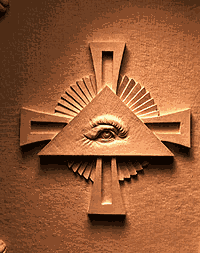 |
|
|
 |
|
|
 |
|
|
|
|
|
Esotericism is described as being knowledge of the occult, either in the form of doctrine or as a technique of symbolic expression reserved for initiates. Esotericism is therefore an ensemble of esoteric practices and teaching, belonging to a context of a multi-featured tradition embracing different eras, places and cultures. Alchemy, Masonry and the Templars, for example, incorporate hermetic theories, rituals and procedures embraced by esotericism:. |
|
|
|
In Judaic type mysticism, taking the form of a search for God and an experience of divinity, esotericism is undamentally based upon the law of correspondence with the objective of finding symbolic relations between the divine and the earthly, the transcendent and the immanent, the visible and the invisible, man and the universe, through the use of analogies. The passage from one dimension to another takes the form of initiation ceremonies, simulations and magic type rituals in which a neophyte is given the secret of ransmutation, agrees to be a member of the group of his fellows and gains access to a higher spiritual level.:. |
|
|
|
Ancient craft Free-Masonry derives from the brotherhoods, corporations, professional groupings of Free Stone Masons and builders of medieval cathedrals. The defence of their professional interests also involved the Free Masons in philanthropic, moral and religious affairs. Masonic groups, organised as secret societies and meeting in lodges began to lose their exclusively operating characteristics and began to accept members from outside the profession but who shared the same initiation ideas:. |
|
|
|
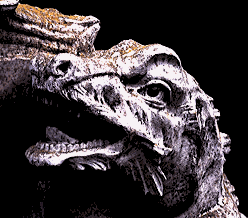 |
|
|
|
|
The decline of the brotherhoods originated the appearance of modern Masonry in England in 1717, by direct affiliation. This is described as being "speculative" owing to the fact that there is no association between the construction trade and in which tools such as set-squares were only symbolic in value:. |
|
|
|
|
|
|
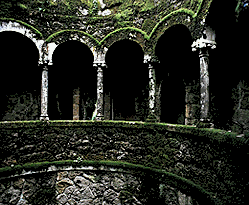 |
|
|
|
Masonry, practically from its very beginning, was opposed by the Catholic Church although much of Masonic teaching, inspired by Christianity, proclaimed belief in the virtues of charity, the immortality of the soul and the existence of a higher spiritual principle referred to as the Great Architect of the Universe. A large proportion of Masonic symbology, particularly those of the higher degrees, are inspired by esoteric currents such as alchemy, templarism and rosicrucianism to which references have been inscribed in various locations in Regaleira:. |
|
|
|
|
|
Notwithstanding the diversity of routes in the Quinta da Regaleira, all paths will lead to a mound of upright stones with the appearance of a menhir and it is herein that a curious stone door activated by a hidden mechanism provides us with entry to another world. This is the monumental initiation well, a kind of inverted tower which plummets into the depths of the earth. The earth is the womb from which life originates but also the tomb to which it will return and many initiation rites refer to aspects of birth and death connected with the earth:. |
|
|
|
The nine levels of this immense spiral gallery which is supported by countless finely worked columns, marking the rate and steepness of the staircase, descend in flights of fifteen steps. The well?s nine circular levels, through which one descends into the bowels of the earth or to which one ascends towards the heavens, depending on the type of initiation route chosen are reminiscent of the nine circles of Hell, the nine sections of Purgatory and the nine heavens of Paradise which were hallowed by the genius of Dante's in his Divina Commedia:. |
|
|
|
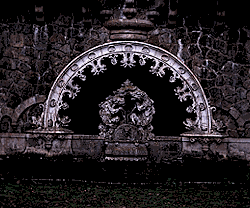 |
|
|
|
|
|
Long acanthus leaves coil around the chapiters of the small columns. The drama of the situation is heightened the further down we go. Engraved in in-laid marble is a Templar Cross, allied with an eight pointed star which is the coat-of-arms of Carvalho Monteiro. The galleries take us through authentic labyrinths into the nether world with the occasional existence of bat colonies. These galleries, most of which have been constructed artificially, make use of the geological characteristics of the granite strata existing in the Serra. The inner arched roof is divided up into the average granular, granite mother lode which is generally pink or darkish and areas containing stone which has been imported from the coastal region of Peniche. This stone, which has been worn by the sea and time, greatly enhances the suggestion of a nether world:. |
|
|
|
Upon reaching the surface, we shall come face to face with the light and carefully constructed scenarios. Fantastic animals, cascading water constructions, stone passages which appear to float on the surface of he lakes, or silent clouds of steam which conceal the entranceways to this most singular universe:. |
|
|
|
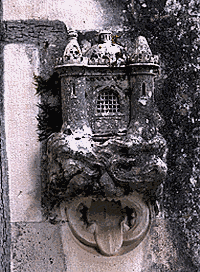 |
|
|
|
Alchemistic symbology appears in various locations in Regaleira. It first appears in the painting of Christ's Coronation of Mary in which the Virgin, in addition to the three colours of Alchemy - blue or black, white, red or glowing red bears a golden sash which could symbolise the Gold of Alchemy:. |
|
|
|
|
|
A twin towered castle separated by a zone of flames and an infernal maw is also to be found on an incline at the back of the Chapel. This is a representation of the threefold unity of the world and man: the higher or spiritual world, the intermediate world of the soul and the material nether world ("ad infero" or hell). The glowing red tower is Althanor, or the alchemistic kiln:. |
|
|
|
There are further signs of Alchemy in the coach houses in the form of two sculptures which form classical symbols of the Art of Hermes: the serpent biting its tail, symbolising Unity, the source and end of the Work and the struggle between the two natures, herein represented by two dragons, each of which bites the tail of the other. Equally susceptible to an alchemistic interpretation is the ogival grotto, in which Leda, holding a dove in her hand, appears in a sculpture at the edge of a small lake whilst Zeus, disguised as a swan, fecundates her by biting her on her leg. This is a pagan allegory or myth, or mystery, of the Immaculate Conception which occurs in a damp and dark place:. |
|
|
|
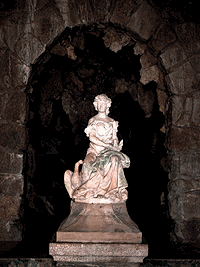 |
|
|
The objective of alchemy is the real or symbolic transmutation of metals into gold with the latter objective of the salvation of the soul. The most commonly referred to alchemistic operations carried out in an Althanor which is a slow burning alchemistic kiln fitted with a crucible and a retort in which the objective is to spiritualise material and materialise the spirit. This essential purpose of operative Alchemy, which is performed in a laboratory is to obtain the Philosopher's stone which is a symbiosis between matter and the spirit which, according to alchemists could, in addition to the transformation of metals into gold, make it possible to achieve one of humanity's ancestral desires: the elixir of long life, capable of providing health and eternal youth. As such, there are those who consider the alchemistic search as a metaphor for the human condition:. |
|
|
|
|
|
|
Alchemy from the 18th century onwards, became clearly religious in character, having particularly concentrated on the study of spiritual and energy associated relationships between man (microcosm) and the universe (macrocosm). On the basis of works of erudition involving equivalencies and analogies, it has been accepted that we are encompassed and challenged by the universe as part of a single existential movement which, is at the same time, transcendence i.e. Other and ourselves:. |
|
|
|
 |
|
|
The Templars were soldier-monks whose military order, founded at the time of the Crusades, in 1119, was to protect the holy places of Palestine from the danger of the infidels. Their votes of poverty and chastity did not prevent the Knights of the Militia of the Temple from enriching and playing an important economic and political role both in the East as in Europe, to such an extent that they made powerful enemies in King Philippe IV of France and Pope Clement V who persecuted the order to extinction in 1314 with trumped up accusations of blasphemy and immorality. In 1317, King Dinis of Portugal endowed the assets of the Templars to the Order of Christ which many accepted as being its successor. Although the Templars disappeared, the Templar philosophy did not and its spirit, whose objective is the protection of sacred places and the struggle against evil, was reborn in various forms and initiation organisations as a symbolic statement of the survival of the Order of the Temple. The Templar cross at the bottom of the initiation well, the cross of the Order of Christ on the floor of the Chapel, as well as the disposition all of the other crosses in the Chapel, bear witness to the influence of the Templar philosophy in the syncretic ideals of Carvalho Monteiro:. |
|
|
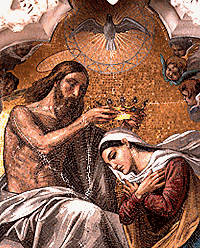 |
|
|
|
Regaleira also contains Rosacrucian references to the Christian esoteric current beginning in the 17th century which used the joint symbols of the rose and the cross. The Rosacrucian movement proposed social and religious reforms, extolled humility, justice, truth and chastity and appealed for the cure of all illnesses of body and soul. It became a Masonic degree in several Orders and, even today, several esoteric schools and secret societies claim to be reappearances of the Rosacrucian myth:. |
|
|
|
|
|
 |
|
|
|
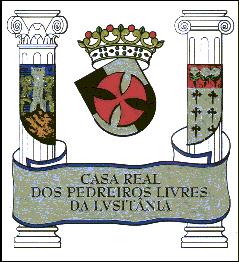 |
|
|
|
 |
|








